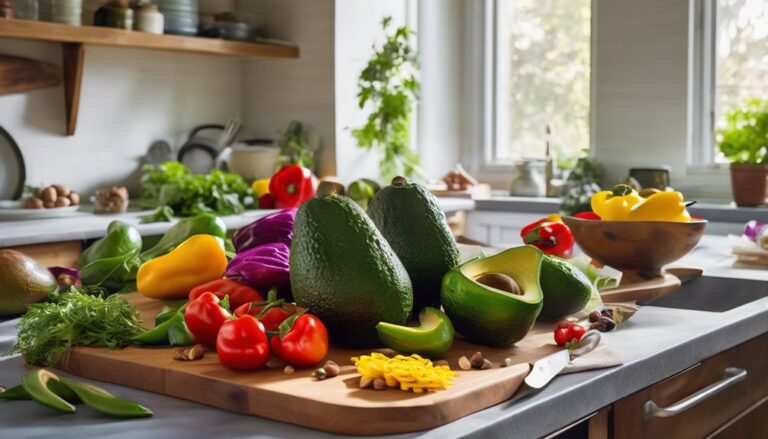Eat More Fiber for Fullness
Imagine a plate brimming with vibrant fruits and hearty grains—each bite bursting with nutrients and fiber that keep you feeling satisfied. You might not realize how essential fiber is for weight management and overall well-being. By incorporating more fiber-rich foods into your meals, you can manage cravings and enhance fullness. But how do you start this journey toward better satiety and health? Let's explore the role of fiber and how you can easily boost your intake.
Key Takeaways
- Incorporate soluble fiber from oats, beans, and fruits to enhance feelings of fullness and satisfaction after meals.
- Choose whole grains over refined grains to increase fiber intake and promote prolonged satiety.
- Snack on fiber-rich options like nuts or popcorn to curb hunger between meals and maintain energy levels.
- Include a variety of fruits and vegetables in your diet to boost fiber content and regulate appetite effectively.
- Stay hydrated by drinking plenty of water, which helps process increased fiber and supports digestion.
Understanding Fiber and Its Role in Satiety
While you may not think much about it, fiber plays a crucial role in keeping you feeling full and satisfied after meals.
When you consume fiber-rich foods, they undergo fiber digestion, which slows the process and prolongs your feeling of fullness. This slow digestion triggers satiety signals in your body, telling your brain that you've had enough to eat.
Foods high in fiber, like fruits, vegetables, and whole grains, not only fill your stomach but also regulate your appetite. By incorporating more fiber into your diet, you can help maintain steady energy levels and reduce those pesky cravings.
Types of Fiber: Soluble vs. Insoluble
Fiber comes in two main types: soluble and insoluble, each offering unique benefits for your digestive health.
Soluble fiber dissolves in water, forming a gel-like substance that can help lower cholesterol and regulate blood sugar levels. You'll find soluble sources in oats, beans, apples, and citrus fruits.
On the other hand, insoluble fiber adds bulk to your stool and aids in moving food through your digestive tract, keeping things regular. You can get insoluble sources from whole grains, nuts, and vegetables like broccoli and carrots.
Including a mix of both types in your diet can enhance your overall well-being, making you feel fuller longer and supporting healthy digestion.
Benefits of High-Fiber Foods for Weight Management
Incorporating high-fiber foods into your diet can significantly aid in weight management, as these foods help you feel fuller for longer.
When you include diverse fiber sources like fruits, vegetables, whole grains, and legumes in your meal planning, you'll find that you naturally consume fewer calories. High-fiber foods slow digestion, stabilizing blood sugar levels and curbing cravings. This means you're less likely to reach for unhealthy snacks.
Plus, fiber-rich meals often require more chewing, giving your brain time to signal fullness. By prioritizing these foods, you not only enhance your meals but also support your weight goals.
Easy Ways to Increase Your Fiber Intake
If you're looking to boost your fiber intake, there are simple strategies you can implement right away.
Start by swapping out refined grains for whole grains—think whole wheat bread and brown rice. Incorporate more fruits and veggies into your meals; they're not just nutritious but also packed with fiber.
You might also consider keeping fiber snacks on hand, like nuts or popcorn, which can help curb cravings between meals. If you find it hard to get enough fiber from food alone, fiber supplements can be a convenient option.
Just remember to drink plenty of water to help your body process the extra fiber. With these small changes, you'll be on your way to feeling fuller and more satisfied.
Delicious Fiber-Rich Foods to Incorporate Into Your Diet
When you want to boost your fiber intake, choosing the right foods can make all the difference. Start by incorporating fiber-rich snacks like almonds or chia seeds into your day.
Tasty legumes, such as lentils and chickpeas, can elevate your meals while providing a hearty dose of fiber. Explore whole grain recipes featuring quinoa or brown rice, and don't forget to add colorful vegetables like broccoli and carrots to your plate.
Fiber-packed smoothies can be a delightful breakfast option, while hearty soups filled with beans and veggies make for satisfying dinners.
Finally, create nutritious salads with a variety of greens and satisfying grains to keep your meals engaging. Embrace these delicious foods, and you'll feel fuller and more energized!
Overcoming Common Challenges When Adding Fiber
How can you smoothly increase your fiber intake without feeling overwhelmed? Start by gradually incorporating fiber sources into your meals.
Begin with fruits, vegetables, and whole grains—these aren't only easy to find but also delicious. Aim to add a small serving each day, allowing your body time to adjust to fiber digestion.
It's normal to experience some bloating initially, so don't rush the process. Drinking plenty of water helps ease these symptoms.
If you find yourself struggling, try mixing high-fiber foods into familiar recipes, like adding beans to soups or oats to smoothies.
Long-Term Health Benefits of a Fiber-Rich Diet
While many people focus on fiber's immediate digestive benefits, its long-term health advantages are equally compelling.
By embracing a fiber-rich diet, you're not just boosting digestive regularity; you're also supporting your overall well-being.
Here are some key benefits you can enjoy:
- Gut Health: Fiber nourishes beneficial gut bacteria, promoting a balanced microbiome.
- Heart Health: A high-fiber intake can lower cholesterol levels, reducing heart disease risk.
- Blood Sugar Control: Fiber helps stabilize blood sugar levels, making it vital for diabetes management.
- Cancer Prevention: Dietary fiber's role in reducing inflammation and promoting nutrient absorption may lower cancer risk.
Incorporating more fiber into your meals can lead to a healthier, happier you.
Frequently Asked Questions
Can I Get Enough Fiber From Supplements Alone?
You can't rely solely on fiber supplement sources. While they help, whole foods offer better fiber absorption rates and essential nutrients. Aim for a balanced diet rich in fruits, vegetables, and grains for optimal health.
How Does Fiber Affect Blood Sugar Levels?
Think of fiber as your blood sugar's best friend. When you consume fiber, it slows digestion and stabilizes blood glucose levels, helping you avoid those pesky spikes and crashes. It's a practical way to support your health.
Is There a Maximum Daily Fiber Intake I Should Consider?
You should aim for about 25-30 grams of fiber daily, depending on your age and gender. Focus on varied fiber sources like fruits, vegetables, and whole grains to meet those daily limits effectively.
Can High Fiber Foods Cause Digestive Discomfort?
High-fiber foods can sometimes cause digestive discomfort, especially if you suddenly increase fiber sources. To promote digestive health, gradually incorporate fiber into your diet, ensuring your body adjusts comfortably to the change.
Are There Specific Fiber Recommendations for Children?
Imagine a garden thriving with diverse plants. For children, fiber sources like fruits, vegetables, and whole grains are essential in childhood nutrition. Aim for age-appropriate daily recommendations to nurture their growth and digestive health.
Conclusion
Incorporating more fiber into your diet can significantly enhance your feelings of fullness and help manage your weight. Studies show that people who increase their fiber intake by just 14 grams per day can lower their calorie intake by up to 10%, which translates to about 2 pounds of weight loss over a month. By making simple changes, like adding fruits, vegetables, and whole grains to your meals, you can reap the benefits of a fiber-rich diet for long-term health.












